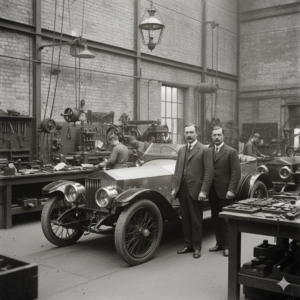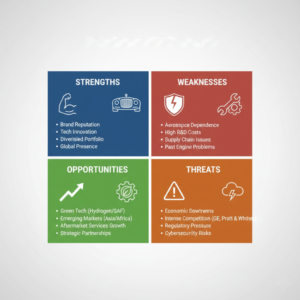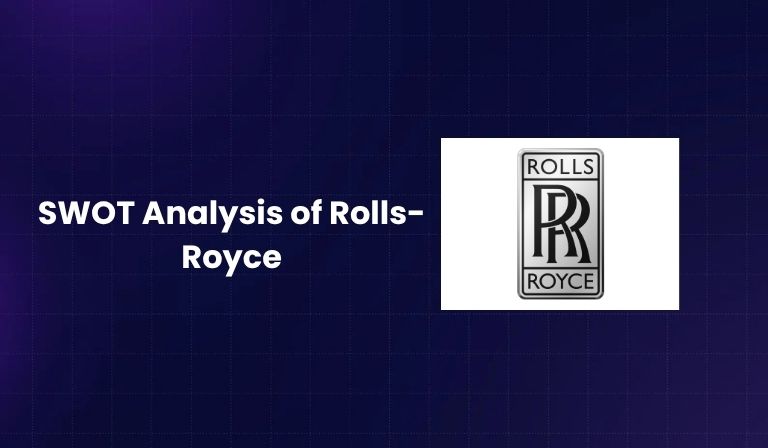Rolls-Royce is one of the most iconic names in global engineering and luxury. The brand represents quality, precision, and innovation. From luxury cars to advanced jet engines, Rolls-Royce has shaped industries for more than a century.
This article provides a SWOT analysis of Rolls-Royce. SWOT stands for Strengths, Weaknesses, Opportunities, and Threats. It helps us see what makes the company strong, where it struggles, what growth chances exist, and what risks it faces.
This Rolls Royce SWOT analysis covers both the engineering group Rolls-Royce Holdings plc and the luxury automobile arm Rolls-Royce Motor Cars.
Company Overview

History and Founding
Rolls-Royce was founded in 1906 by Charles Rolls and Henry Royce. The company’s first focus was luxury automobiles, known for engineering excellence. Over time, it expanded into aviation and power systems, becoming a leader in civil aerospace and defense.
Today, Rolls-Royce Holdings is best known for designing and manufacturing aircraft engines and energy systems. Rolls-Royce Motor Cars, owned by BMW since 1998, continues the tradition of building some of the most luxurious cars in the world.
Business Segments of Rolls-Royce Holdings
- Civil Aerospace
- Rolls-Royce is a leader in engines for widebody aircraft.
- Its Trent series engines power aircraft like Airbus A350, A330, A380, and Boeing 787 Dreamliner.
- It holds nearly 40% market share in widebody jet engines.
- Civil aerospace contributed 48% of revenue in 2023.
- Defence
- Supplies military engines for fighter jets, helicopters, and transport aircraft.
- Engines like EJ200 (used in Eurofighter Typhoon) and Adour (used in Hawk trainer jets) highlight its defense presence.
- Naval propulsion systems power submarines and naval ships.
- Defence accounted for 26% of revenue in 2023.
- Power Systems
- Operates under the MTU brand.
- Provides engines and power solutions for railways, mining, oil & gas, agriculture, and marine vessels.
- In 2023, this division also contributed 26% of revenue.
- Nuclear
- Supplies reactor systems and propulsion for UK’s nuclear submarines.
- Offers services to civil nuclear power plants.
- Plays a key role in long-term defense contracts with the UK government.
Rolls-Royce Motor Cars
- Owned by BMW Group.
- Produces ultra-luxury cars like Phantom, Ghost, Wraith, Dawn, and Cullinan SUV.
- In 2022, Rolls-Royce Motor Cars sold 6,021 vehicles, a record high, with North America as the biggest market.
- Cars are handcrafted with extensive customisation, making each vehicle unique.
Financial Snapshot 2023
- Total revenue: £15.4 billion
- Operating profit: £1.6 billion
- Revenue breakdown:
- Civil Aerospace – 48%
- Defence – 26%
- Power Systems – 26%
What is SWOT Analysis?

SWOT analysis helps understand a company’s position in the market. It identifies internal factors (strengths and weaknesses) and external factors (opportunities and threats).
By doing a swot analysis of Rolls Royce, businesses, investors, and students can see what drives the company forward and what challenges it must overcome.
Strengths
- Brand Reputation and Heritage
Rolls-Royce has a global reputation built over a century. It is associated with luxury, precision engineering, and reliability.- The car brand is a status symbol among billionaires and celebrities.
- The engineering division has trusted contracts with airlines and governments.
- Strong heritage helps secure long-term deals in defense and aerospace.
- Technological Innovation
Rolls-Royce invests heavily in R&D. In 2022, it spent over £1 billion on research and development.- The Trent XWB is one of the most efficient large aero engines in the world.
- It is also developing hybrid-electric propulsion systems.
- Continuous innovation ensures competitiveness against rivals like GE and Pratt & Whitney.
- Diversified Portfolio
The company operates across aerospace, defense, nuclear, and power systems.- This reduces dependence on any one industry.
- Example: Even during downturns in civil aviation, defense contracts provide steady revenue.
- Global Presence
Rolls-Royce operates in 150+ countries.- 80% of widebody aircraft flying today use Rolls-Royce engines.
- Rolls-Royce Motor Cars exports luxury vehicles to more than 50 markets.
- Aftermarket Services
Rolls-Royce earns recurring income through maintenance, repair, and overhaul (MRO) contracts.- “Power by the Hour” model charges airlines for engine usage rather than upfront sales.
- This creates stable, long-term cash flow.
- Strong Customer Relationships
- Defence contracts with NATO, UK Ministry of Defence, and US Department of Defense.
- Multi-decade partnerships with airlines such as British Airways, Singapore Airlines, and Emirates.
- Commitment to Sustainability
Rolls-Royce is working on net-zero aviation goals by 2050.- Projects in hydrogen propulsion and electric aviation (Spirit of Innovation electric plane set a speed record in 2021).
- Skilled Workforce
Rolls-Royce employs over 40,000 people worldwide.
- The company has strong expertise in design, engineering, and nuclear technology.
Also Read: SWOT Analysis of Jeep
Weaknesses
- Dependence on Aerospace
- Almost half of revenue comes from civil aerospace.
- Any slowdown in aviation, like during COVID-19, leads to heavy financial losses.
- High R&D Costs
- R&D spending crosses billions annually.
- While it drives innovation, it reduces profits.
- High investment is needed to keep up with new technologies like hydrogen and electric propulsion.
- Complex Manufacturing and Supply Chains
- Building advanced engines involves thousands of suppliers.
- Disruptions in supply chains delay deliveries.
- Example: Global semiconductor shortages in 2021 affected the Power Systems division.
- Past Product Issues
- The Trent 1000 engine used in Boeing 787 faced technical failures.
- Repairs cost Rolls-Royce over £2 billion between 2017 and 2020.
- Damaged customer trust and financial performance.
- Luxury Cars as a Niche Market
- Rolls-Royce Motor Cars sells to ultra-rich customers only.
- High pricing restricts its customer base.
- Status Symbol Image
- Rolls-Royce cars are seen as unattainable for most people.
- While this creates exclusivity, it also narrows the audience.
- Environmental Concerns
- Aviation contributes about 2.5% of global CO2 emissions.
- Rolls-Royce faces pressure to cut emissions faster.
- Workforce Reductions
- During COVID-19, Rolls-Royce cut 9,000 jobs.
- Such measures reduce costs but lower morale and risk losing expertise.
Opportunities
- Green Technologies
- The aviation industry is under pressure to move toward zero emissions.
- Rolls-Royce is investing in hydrogen engines, hybrid-electric systems, and sustainable aviation fuels (SAF).
- Example: Its “Spirit of Innovation” electric plane hit 623 km/h, breaking speed records.
- Expansion in Emerging Markets
- Asia-Pacific and Africa are key growth markets for both civil aviation and defense.
- Countries like India, China, and Indonesia are expanding air travel demand.
- Aftermarket Services Growth
- Airlines prefer long-term service agreements.
- Predictive maintenance using AI and IoT can boost customer loyalty.
- Strategic Partnerships
- Collaborating with Airbus, Boeing, and universities on electric aviation.
- Partnerships with governments on defense projects secure decades of revenue.
- Diversification
- Space exploration and renewable energy are new frontiers.
- Rolls-Royce is working with the UK Space Agency on nuclear-powered space reactors.
- Digital Transformation
- Use of AI, IoT, and robotics in manufacturing.
- Increases efficiency, reduces costs, and speeds up innovation cycles.
- Luxury Car Customisation
- Rolls-Royce offers “Bespoke” customisation programs.
- Example: Customers can personalize everything, from interiors to paint, leading to higher margins.
- Talent Development
- Building strong training programs helps retain engineers.
- Ensures knowledge transfer as older engineers retire.
Threats
- Economic Downturns
- Aviation demand drops during recessions.
- Luxury car demand falls as high-net-worth individuals cut spending.
- Intense Competition
- Aerospace rivals: General Electric, Pratt & Whitney.
- Luxury car rivals: Bentley, Mercedes Maybach, Lamborghini.
- Technological Disruption
- Electric aircraft and self-driving cars could reduce Rolls-Royce’s edge.
- Smaller startups can innovate faster.
- Regulatory and Environmental Pressure
- Stricter emission rules may make older engines non-compliant.
- Developing new solutions adds costs.
- Geopolitical Risks
- Defense contracts depend on political stability.
- Trade disputes can block sales in key markets.
- Cybersecurity Risks
- As a defense contractor, Rolls-Royce is a prime cyber target.
- Attacks could expose sensitive military technology.
- Supply Chain Disruptions
- Wars, pandemics, or natural disasters delay deliveries.
- Increases costs and damages trust.
- Currency Fluctuations
- A global business faces risks from exchange rate changes.
- Profit margins are affected by pound-dollar and pound-euro shifts.
- Talent Competition
- Competes with GE, Airbus, and tech companies for engineers.
- Losing talent weakens innovation capacity.
Strategic Insights from the SWOT
The Rolls Royce SWOT analysis shows the company’s unique position. It is strong in heritage, technology, and global contracts. But it faces internal pressure from high costs and product issues.
Opportunities lie in green aviation, digital transformation, and new markets. Threats include competition, regulation, and economic cycles.
The path forward is clear: invest in sustainability, secure global defense contracts, expand in emerging markets, and protect its premium positioning in cars.
Conclusion
The swot analysis of Rolls Royce highlights a company that balances history and innovation. It has unmatched strengths in engineering and branding, but it must address weaknesses like dependence on aerospace and environmental concerns.
If it continues to innovate in green technologies and expand globally, Rolls-Royce can remain a leader in aerospace and luxury for decades to come.
FAQs
What are the strengths of Rolls-Royce?
Brand reputation, global presence, technological leadership, diversified portfolio, and strong aftermarket services.
What are the weaknesses of Rolls-Royce?
Over-dependence on aerospace, high R&D costs, past engine failures, and luxury cars limited to niche buyers.
What opportunities exist for Rolls-Royce?
Green aviation, emerging markets, predictive maintenance, space exploration, and luxury car customisation.
What threats does Rolls-Royce face?
Competition from GE, Pratt & Whitney, and Bentley, regulatory pressures, economic downturns, and cyber threats.
Is Rolls-Royce only about luxury cars?
No. Rolls-Royce Holdings focuses on aerospace, defense, nuclear, and power systems, while Rolls-Royce Motor Cars, owned by BMW, makes luxury cars.
A digital marketer with a strong focus on SEO, content creation, and AI tools. Creates helpful, easy-to-understand content that connects with readers and ranks well on search engines. Loves using smart tools to save time, improve content quality, and grow online reach.

